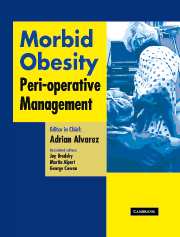Book contents
- Frontmatter
- Contents
- Contributors
- Foreword
- Preface
- Acknowledgments
- Dedication
- Section 1 General aspects
- Section 2 Pathophysiology
- Section 3 Pre-operative management
- Section 4 Peri-operative management of co-morbidities
- Section 5 Pharmacology
- Section 6 Monitoring
- 17 Electrocardiography
- 18 Respiratory monitoring
- 19 Cortical electrical activity monitoring
- Section 7 Intra-operative management
- Section 8 Post-operative care
- Section 9 Conclusions
- Afterword
- Index
18 - Respiratory monitoring
from Section 6 - Monitoring
Published online by Cambridge University Press: 17 August 2009
- Frontmatter
- Contents
- Contributors
- Foreword
- Preface
- Acknowledgments
- Dedication
- Section 1 General aspects
- Section 2 Pathophysiology
- Section 3 Pre-operative management
- Section 4 Peri-operative management of co-morbidities
- Section 5 Pharmacology
- Section 6 Monitoring
- 17 Electrocardiography
- 18 Respiratory monitoring
- 19 Cortical electrical activity monitoring
- Section 7 Intra-operative management
- Section 8 Post-operative care
- Section 9 Conclusions
- Afterword
- Index
Summary
Introduction
As much as one-third of the population in the US weigh 20% or more than the ideal body weight at the present time. One measure of obesity is body mass index (BMI) equal to the ratio of weight (kg) divided by the square of the height (m). An index value over 27 in women and 28 in men represents a weight excess of 25% over ideal, and a BMI of 31 or higher is commonly accepted to represent morbid obesity. The clinical consequences of obesity involve all major organ systems: animal models have been developed in rats to study the metabolic changes induced by obesity and physiological changes can be readily verified in man because they can be induced by overfeeding in normal subjects and can be reversed by dietary restrictions. Therefore, it is possible to reduce some of the extreme risks in morbid obese patients facing elective surgery by a weight reduction diet and judicious postponement of elective procedures.
Obesity is a significant health risk, which leads to overall overuse of health resources, increased hospitalization, and increased peri-operative risks. In this chapter we focus to review the respiratory system and the related monitoring strategies: first we describe the altered respiration physiology in obese patients, then pre-operative evaluation, intra-operative monitoring, and post-operative strategies. Finally, we discuss surveillance after surgical procedures. We selected recent key references narrowly related to the anesthetic field.
- Type
- Chapter
- Information
- Morbid ObesityPeri-Operative Management, pp. 255 - 260Publisher: Cambridge University PressPrint publication year: 2004



